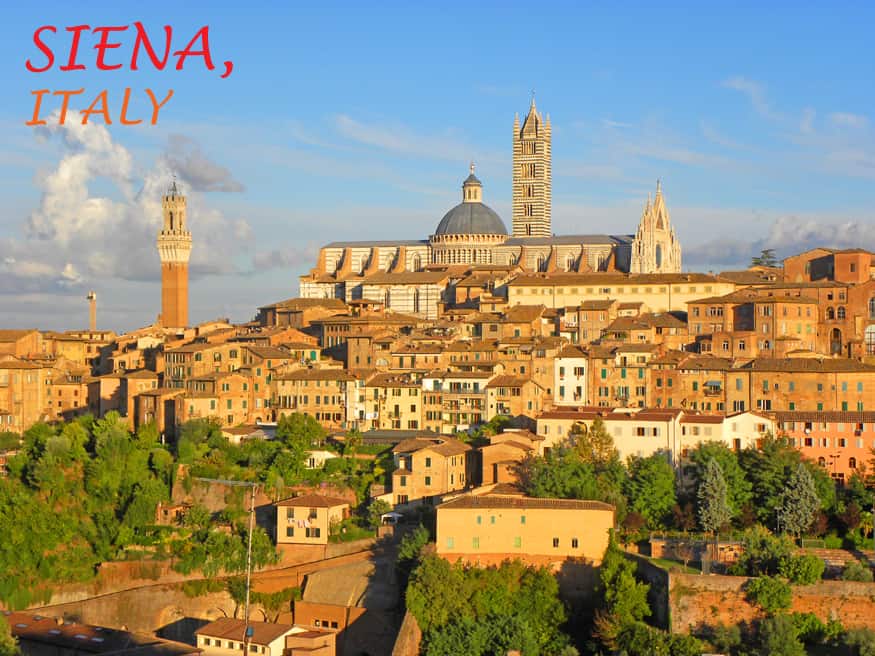“Tuscany’s Lovely & Intriguing Medieval City!”
Siena is a most intriguing and historical city perceived by many as Italy’s loveliest medieval city. Basically a huge open-air museum, Siena flaunts its splendid Gothic spiritual and secular heritage in its buildings, monuments, and art collections. It is also famous for its cuisine, its splendid medieval cityscape, and the Palio horserace. Historic Siena has been declared a World Heritage Site by UNESCO and is one of the most visited tourist attractions in Italy. Siena rates at the top of the Tuscan cities we visit on our week in Tuscany. To truly capture the essence of Siena, we are taking a private tour with Associazione Centro Guide Siena. Fabulous, our guide, Francesca is an art historian providing a fantastic tour of Siena.
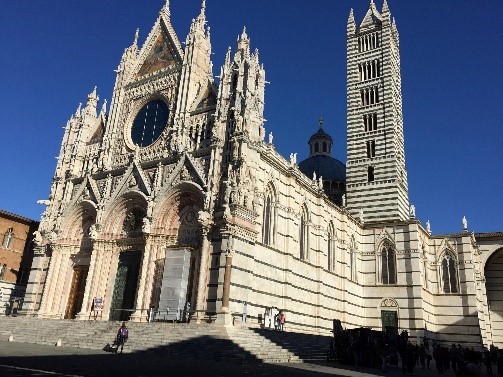
Francesca intrigues us with Siena’s legendary founding by Senius, son of Remus, one of the two legendary founders of Rome. Consequently, the she-wolf, who suckled Remus and Romulus, is the emblem of Siena with numerous statues throughout the city. Black and white are the symbolic colors of Siena based on the etiology of the black and white horses of its legendary founders, Senius and Aschius. Accordingly, the Siena Cathedral is majestic and symbolic with its magnificent greenish-black and white marble exterior with alternating stripes. The Cathedral’s shape is the form of a Latin cross with a slightly projecting transept, a dome and a bell tower. Dedicated to the Virgin Mary, the Cathedral’s Upper façade is an elegant mosaic of the Coronation of the Virgin. Francesca explains thirty-five statues of prophets and patriarchs group around the virgin on the Cathedral’s facade. The “importance of knowledge in our lives” is the theme of the Cathedral and on the façade is represented by the statutes of Plato and Socrates.
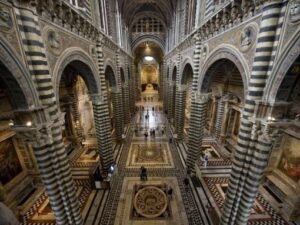
Having visited El Duomo, Florence’s Cathedral, we are familiar with the competition between Florence and Siena for the greatest cathedral and the goal to be Tuscany’s leading city. While Florence won as the leading city, Siena won with the Cathedral’s fabulous interior. Throughout the entire Cathedral the theme of “knowledge” is in all the artwork. The inside is absolutely majestic as Italy’s finest artists completed works in the Cathedral. Francesca points out the wonderful works of Giovanni Pisanno, Donatello, Lorenzo Ghiberti and Bernini, as well as, the significance of each work of art’s relation to the theme of “knowledge.” Even the floors have wonderful mosaics depicting prophets and stories of knowledge and wisdom.
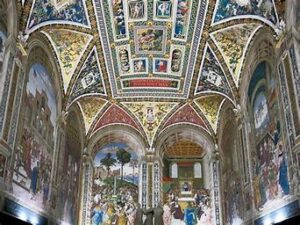
Our education continues at a small library in the Cathedral as we discover the significance of the Piccolomini family, who had two Popes in the family. The Library, Biblioteca Piccolomini, is dedicated to Pope Pious II by his nephew who later became Pope Pious III. Inside the library is like a mini-Sistine Chapel with its elaborate ceiling and wonderful frescoes. The Library contains a rich collection of manuscripts of Pope Pious, as well as, elegant choir books. Outside we see Facciatone, large black and white structures initially planned to enlarge the main church. The goal was to make Duomo Siena the largest church in Italy. Once Siena lost its growth to Florence, the expansion ceased. Today, the Facciatone stand as reminders of the city’s dream in the past.
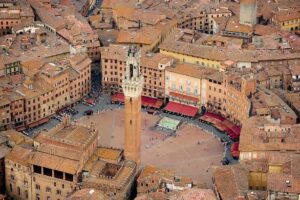
As the tour continues, we realize Siena is not the typical Italian city. Its medieval atmosphere sets it aside from other cities. Historians believe that the harmonious look of the city was made possible due to the ongoing competition with nearby Florence. Both cities fought constantly for superiority in Tuscany. The city of Florence won the “battle” while Siena seemed to freeze in time, retreating into the shadows of history. Perched on three hills its architecture is of brown walls, the austere Church of San Domenico, the Torre Del Magia tower and the shell-shaped Piazza del Campo. The village dates to 900 BC with its early growth attributed to its central location on the trail between Pisa and Rome. Becoming a major stopping point for travelers, Siena attracted merchants and many buildings were constructed. A complete circuit of medieval walls surrounds the ancient buildings while narrow twisting streets lead to the magnificent Piazza del Campo, one of the most stunning public squares in the world. The Piazza is also known worldwide for the Palio di Siena, a horse race held twice each summer. Ten horses and riders, bareback and dressed in the appropriate colors, represent ten of the seventeen city wards. The Piazza del Campo is huge and is definitely a gathering place today as it was centuries ago.
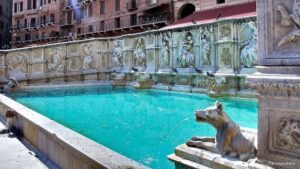
At the Fonte Gaia, a monumental fountain located in the Piazza del Campo, Francesca reveals that Siena’s challenge to become a major city was due to it not being located on a river. Water is extremely precious to the city and it took 8 years to get the waterworks system in the 1300’s to the hilltop on which Siena sits. Gaia means “Joyful” and the people were definitely joyful to have water coming into the city and not having to be transported. Back then this water supply was used by the locals for their everyday water and washing. The artwork around the fountain has the Madonna and Child, a symbol taken from Lorenzetti’s Allegory of Good Government. On each side are two angels, the Theological and Cardinal Virtues and Justice. The wolf represents the wolf who nursed Romulus and Remus. Francesca strolls us through much of Siena pointing out historic buildings, unique shops, and sharing a wealth Siena’s intriguing history.
As Francesca winds to the outskirts of Siena, we arrive at Basilica di San Domenico, a large edifice sitting high on a hill beside the walled city. The interior is on the Egyptian cross plan with a huge nave covered by trusses and with a transept featuring high chapels. As the Basilica is going through reconstruction much of it is closed off limiting the ability to truly appreciate it. We are able to see a few of the relics of St. Catherine of Siena that are housed in the church. Siena is the birthplace of Saint Catherine, who experienced visions from an early age and seemed destined for sainthood. She is most noted for convincing the papacy to move back to Rome from Avignon, France.
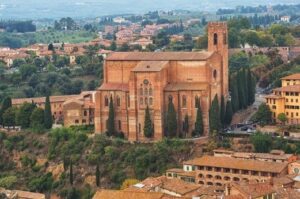
Following our tour and on recommendations from Francesca we have an excellent lunch at Antica Trattoria. It is a local restaurant away from the crowds at the Campo. Our tickets to Siena Cathedral include access to the Baptistery and the Crypt, so we are off to see these sites. Battistero di San Giovanni, Baptistery of St. John, was built to accommodate the huge number of people converting to Catholicism, which only held baptisms at certain times of the year. It is exquisite inside with the hexagonal baptismal font in bronze, marble and enamel. Various statues, frescoes and other artwork of noted Italians of the time are impressive. The Baptistery artwork focuses on John the Baptist including panels that represent the Life of John the Baptist. Each are exquisite especially notable are the “Baptism of Christ” by Gheiberti (1427) and “The Feast of Herod” by Donatello (1427).
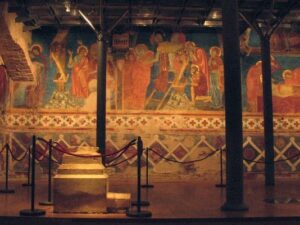
The crypt, Siena Crypt, is an intriguing place to visit. It was actually constructed at the same time as the Cathedral (13th century). Basically abandoned for 700 years, it was re-discovered in 1999. The crypt is rectangular, bare, and of little architectural interest, but that is all the better to appreciate what remains of a magnificent fresco cycle painted c.1270-80. Originally, there was a full cycle of Old Testament stories along the top of the wall and a parallel cycle of New Testament stories below. Sadly, the former have been lost due to the destruction of the vault. Among the scenes that remain are the Annunciation, Visitation, Nativity, Kiss of Judas, Crucifixion, Deposition, and Entombment of Christ. These spectacular historical frescoes are in vibrant colors primarily of red, blue and gold.
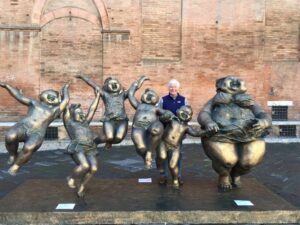
Next we stroll the many unique shops along the winding streets and check out the various merchants and vendors around Piazza del Campo. Our shopping is a success as we each buy a beautiful pair of Italian leather shoes at a very good price. Now it is time to head back to our rental Villa apartment in Poggibonsi, planning to arrive before dark. Our rental car is gone! It’s been towed! Thankfully, the manager at a nearby hotel is most helpful providing a letter for the police and assisting with getting a taxi to the Towing Company. Looks like our “bargain Italian shoes” weren’t such a bargain after paying the fine, the taxi to the Towing Company, and the towing fee. Whenever we wear our Italian shoes, we recall fond memories of Siena and chuckle that these are the most expensive shoes we own.
Follow our road trip and adventures as we travel to through Italy from Rome to Florence to Tuscany to Siena to Venice.
If you go:
Associazione Centro Guide Siena – we highly recommend a guided tour on a visit to Siena. Centro Guide offers various group tours of Siena, so decide which best fits for your visit. The private tour was excellent with Francesca.
Tel +39 0577 43273
Email Info@Guidesiena.It
https://www.guidesiena.it/en/.
Travel Tips:
• Visiting in the Fall avoided the crowds of summer and other seasons making it a comfortable and casual visit. The weather was sunny and comfortable even in November.
• Parking is a major challenge in Siena. A person we met shared he got a hefty parking fee in Siena, so we were very careful and researched the best places to park. Based on Rick Steve’s (Rick Steve’s Europe), we easily found a parking space at the Soccer Field. Yet, our car was still towed. We did not realize there was a Soccer game that night, which is the reason the car was towed. Do research on parking in Siena to avoid parking fines and towing. Specifically the fine was 27 Euro, the taxi was 20 Euro and the towing fee was 135 Euro totaling 182 Euro.
• Plan a Tour – we highly recommend a tour of Siena. The tour provides a wealth of information on the city, its history and so much more. Taking the tour in the morning gave us time to explore on our own in the afternoon and already know our way around the city.
• Dining – as does all of Tuscany, dining is excellent. We especially liked getting away from the crowds and to a more local eatery. While Francesca gave us the restaurant, we have been very successful asking local merchants for suggestions.
• Train access – we actually took the train from Florence to Siena on our one week in Tuscany then rented the car in Tuscany. This can also be an option for visiting Siena for the day from Florence or other cities. Note: The station is located on Piazza Carlo Rosselli is roughly a 1.3-mile walk to the Piazza del Campo in the historic center of Siena . The train station is outside the city walls, and the uphill walk into the center can be steep.
• Overnight in Siena – for our visit, we opted to do a day visit in Siena. After visiting the city, it would have been good to spend at least one night to take in more sights and have more leisure time to enjoy the city.

